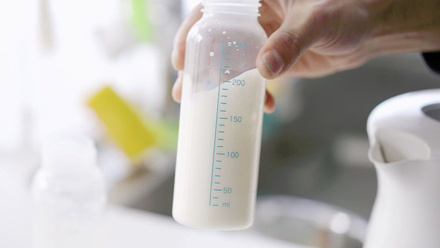Home testing kits have proved popular among the public looking to better understand whether they have food allergies. Annabel van Griethuysen takes a closer look.
Allergy management, and advancements in allergy research, has been a rapidly developing area, even since I was a student (quite a few years ago now!) I remember reading articles about a treatment vaccine for allergies – I think it was peanut allergy – and advice seemed to be ever changing aiming to prevent childhood allergies developing, such as avoiding high-allergen foods in pregnancy and then switching to including high-allergen foods, and debates about when to wean and what to wean on. It is easy to see why dietitians, and especially the general public, may find this a confusing and overwhelming area.
Recent updates to UK law to provide greater protection for those with allergies have brought the topic of allergy management to the forefront again. ‘Natasha’s Law’ was introduced in October 2021 and adds the requirement that all food outlets must provide a clear allergen label and ingredients list on all ‘prepacked for direct sale’ foods. These are foods that are prepared, prepacked and offered or sold on the same premises. This was prompted through the tragic death of Natasha Ednan-Laperouse on 17 July 2016 after eating sesame seeds that were baked into the dough of a baguette she had purchased at Heathrow Airport. The package had no allergen labelling and the ingredient was not reported.3
Management of allergies is certainly a specialist area. However, working as a dietitian you are virtually guaranteed to encounter a patient with a food allergy at some point in your career. Allergy UK, the UK’s leading allergy charity, states that the UK has one of the highest allergy prevalence rates in the world, with over 20% of the population affected by an allergic disorder. Over 44% of British adults report to suffer from at least one allergy. Younger people under 35 years are the most likely to report an allergy with 50% claiming to have one. There was also a significant increase in the number of hospital admissions for anaphylaxis of 615% between 1992 and 2012.1
Traditionally, testing for an allergy includes a comprehensive history being taken by a medical professional. Following this, the most common diagnostic tests are prick tests, where a drop of liquid is placed onto the skin, usually the forearm, and then the skin underneath that drop is pricked. The result, if an allergy is present, is a raised, itchy bump on the skin. The alternative is a blood test, which can be used to test for specific antibodies that the body produces in response to an allergen.2
However, a new method has arrived on the block for allergy testing, Home Allergy Testing Kits. These kits provide allergy testing for people at home, posting results back in the mail, to diagnose food and environment allergies. These test kits use a variety of methods to collect information, including finger-prick blood samples and hair samples testing.
Blood sample testing kits claim to work by detecting IgG antibodies in the blood, an antibody reported by these kits that is created by the body to ‘fight’ certain allergenic foods. The tests often state that these antibodies are involved in inflammation and provide guidance on which foods to avoid. Some kits even state that avoiding these foods could also help cure Crohn's disease, diabetes, depression, obesity and more. However, this is incorrect, as IgG are normal antibodies found in the body in response to fight infections and the production of these antibodies is a normal response to eating food. This is different to IgE antibodies, which are understood to be responsible for allergic responses.4 One study used 150 patients with IBS and randomised them into two categories: one group had a diet which eliminated IgG ‘positive’ foods and the other a ‘sham’ diet. Better outcomes were reported in those with the IgG elimination diet. However, the trial design was poor and the reproducibility of the results also poor.5
The science that underpins these home allergy tests is not well substantiated and many of the labs which provide testing are not accredited
Hair analysis testing works through examining a person’s hair for mineral content. The theory behind this in regards to allergies is that a harmful food will show up in the hair’s mineral composition. This is also not an accurate method, particularly due to the slow rate of growth of human hair, so even hair at the top of the head is weeks or months old, and therefore not able to determine what the current health condition of the body is.4 A trial of nine healthy subjects failed to show reproducibility of results when hair samples were sent to three separate labs in regards to allergy testing.5
Some of these kits also even provide advice on elimination diets once the results are returned to the individual. This is highly concerning as the results provided can be very misleading. The advice to restrict and eliminate certain foods, and even entire food groups, needs to be provided by professionals with the skills and abilities to monitor and follow up patients, which none of these allergy testing kits are able to provide.
Generally, the science that underpins these home allergy tests is not well substantiated and many of the labs which provide testing are not accredited.5 Research has stated that these food allergy tests may “unanimously provide potentially misleading results to consumers”.5 As a result of this, the NHS, Allergy UK, the Allergy Academy and NICE all do not recommend the use of these home allergy testing kits.
So why do people choose to take these tests? Particularly during the pandemic, it may be perceived as easier to gain a diagnosis using these home kits, and a lot more convenient with a test kit arriving through the post. These tests are readily available online; a Google search generated over 36 million results, the first page of which were all special offers of various testing kits. If you click on any of these test webpages, you are greeted with glossy, professional websites promising scientific results and support.
These tests are unlikely to be useful for allergy diagnosis but can these tests actually be harmful? There is limited evidence to support this. However, there are many ways that these tests could do more harm than good. Firstly, these tests can provide wide, sweeping indications of intolerances, which could lead to several foods being eliminated from the diet. One test reports to test for over 23 allergens in food, including carrot, apple, wheat, potato, rice and peanuts.6 In my professional practice I have seen patients with lists of foods they are reported to be intolerant, or allergic, to. Often these include things which are hard to exclude, such as yeast, or entire food groups such as dairy. As we know, elimination diets are extremely challenging, to ensure that all items containing the avoided food are excluded, and also that the diet is balanced to compensate for the nutrition of excluded items. Without support from nutrition professionals, this can be very overwhelming and challenging for people to follow on their own and, at worst, can lead to nutritional deficiencies of overly, and often unnecessarily, restrictive diets. The other risk is, if a genuine severe allergy is present, and the appropriate consultations with nutritional professionals to safely and completely remove the food from the diet is not sought, does this run the risk of the person having accidental, and potentially fatal, exposure?
The other client group that I have often found using home allergy testing kits is people with eating disorders. Many times, as a result of prolonged starvation and inadequate oral diet, gastrointestinal symptoms that present very similarly to intolerances can occur. These tests can then provide seemingly credible explanations for the patient for these uncomfortable symptoms, and a potential relief. Also, for some people with restrictive eating disorders, these intolerance and allergy tests can add a barrier to adding certain high-calorie items into the diet, which is difficult to challenge. It can take months, and even years, to break down these food rules, not only for those with eating disorders, but for those who are searching for answers to gastric symptoms.
So, what should we as dietitians do about this? My go-to line is always education: share our knowledge to empower our patients. It can be uncomfortable to challenge a patient if they present with test results detailing a long list of foods they need to avoid, and it wouldn’t be appropriate to encourage a patient to add foods in that they believe they are allergic or intolerant to. Encourage the patient to attend evidence-based allergy testing to confirm any allergies. Once allergies are confirmed or not, it may take a long time to work through a highly restricted diet with the patient and break down anxieties around food.
It would appear that these test kits are too inaccurate and can do more harm than good. The best way to support diagnosis of allergies for individuals remains through NHS-approved diagnostic IgE testing and skin-prick testing, with the support of dietetic professionals to establish balanced, safe and achievable long-term diets for people, alongside education to promote confidence and independence around eating.







